Leadership and Management: Roles, Theories, and Application
VerifiedAdded on 2020/07/22
|19
|5784
|54
Report
AI Summary
This report provides a comprehensive comparison of leadership and management, examining their distinct roles, responsibilities, and the application of various theories within an organizational context, using H&M as a case study. It defines and contrasts the characteristics of leaders and managers, evaluating their functions through theories like trait and behavioral theories for leadership, and human relation and chaos theories for management. The report analyzes leadership styles, decision-making processes, and the importance of team building, communication, and adapting to different organizational situations. It also assesses the impact of various factors on operational management and the business environment, highlighting how leaders and managers can improve business activities and achieve organizational goals. The report includes an evaluation of the roles of leaders and managers in different situations (integrative, flexibility, hierarchical), and the application of leadership and management principles to guide business activities.
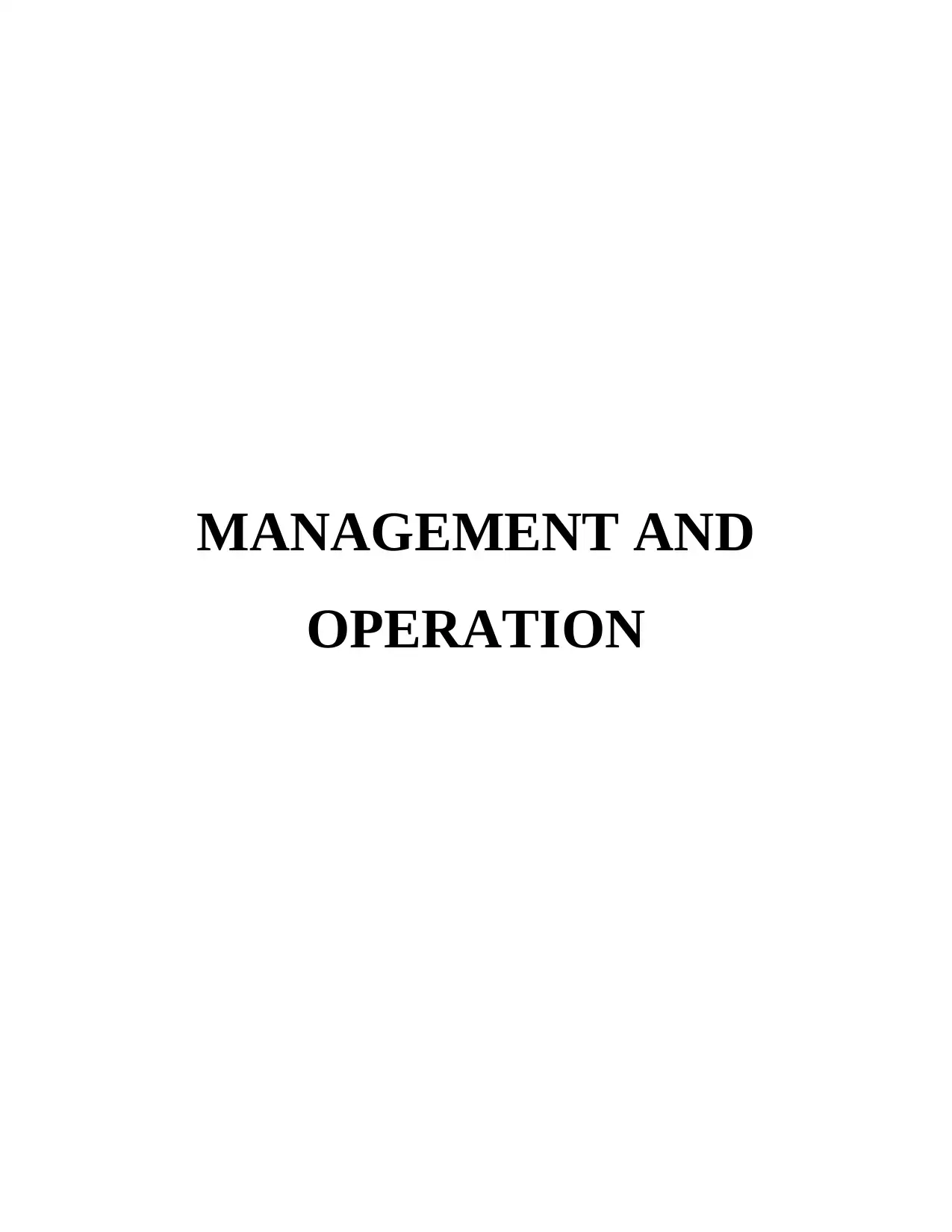
MANAGEMENT AND
OPERATION
OPERATION
Paraphrase This Document
Need a fresh take? Get an instant paraphrase of this document with our AI Paraphraser
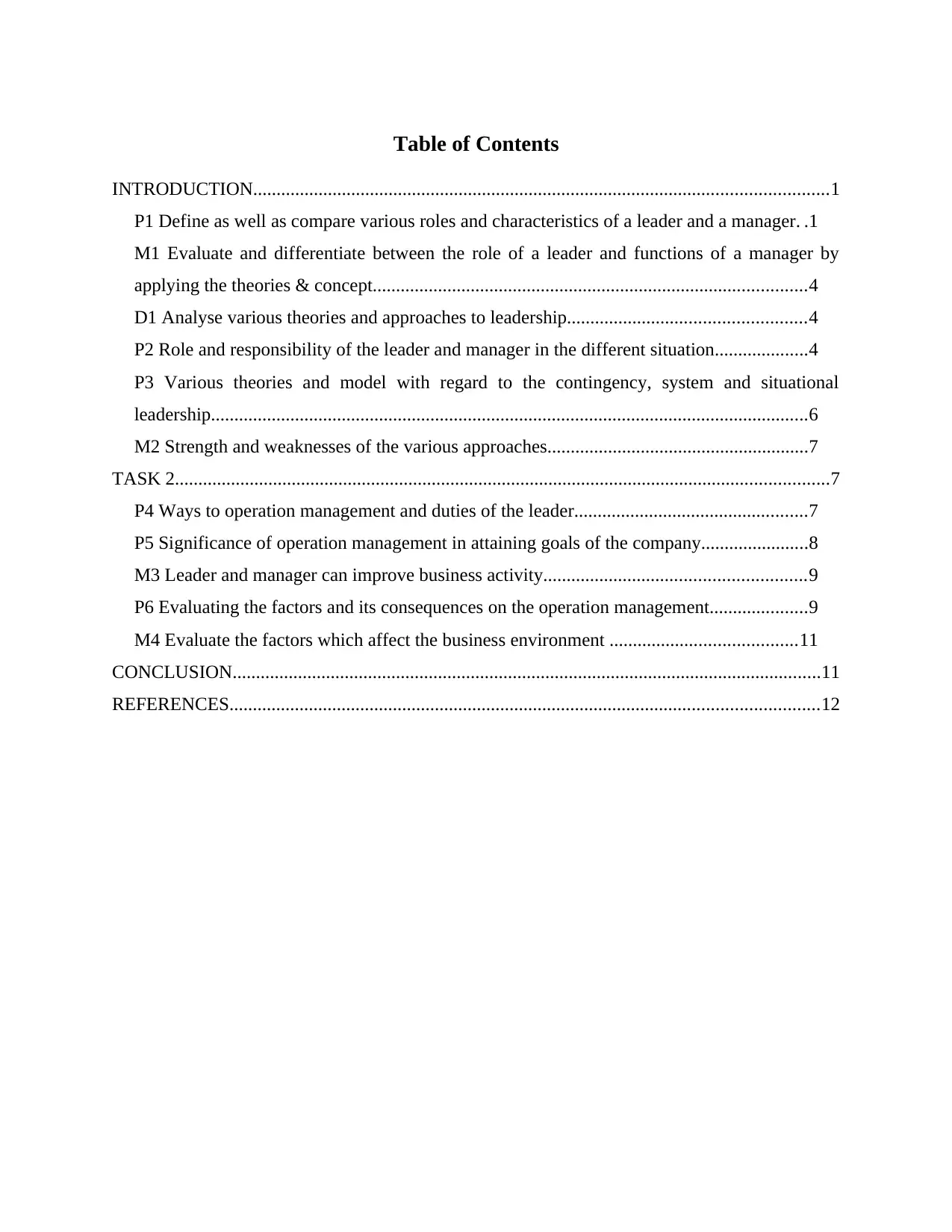
Table of Contents
INTRODUCTION...........................................................................................................................1
P1 Define as well as compare various roles and characteristics of a leader and a manager. .1
M1 Evaluate and differentiate between the role of a leader and functions of a manager by
applying the theories & concept.............................................................................................4
D1 Analyse various theories and approaches to leadership...................................................4
P2 Role and responsibility of the leader and manager in the different situation....................4
P3 Various theories and model with regard to the contingency, system and situational
leadership................................................................................................................................6
M2 Strength and weaknesses of the various approaches........................................................7
TASK 2............................................................................................................................................7
P4 Ways to operation management and duties of the leader..................................................7
P5 Significance of operation management in attaining goals of the company.......................8
M3 Leader and manager can improve business activity........................................................9
P6 Evaluating the factors and its consequences on the operation management.....................9
M4 Evaluate the factors which affect the business environment ........................................11
CONCLUSION..............................................................................................................................11
REFERENCES..............................................................................................................................12
INTRODUCTION...........................................................................................................................1
P1 Define as well as compare various roles and characteristics of a leader and a manager. .1
M1 Evaluate and differentiate between the role of a leader and functions of a manager by
applying the theories & concept.............................................................................................4
D1 Analyse various theories and approaches to leadership...................................................4
P2 Role and responsibility of the leader and manager in the different situation....................4
P3 Various theories and model with regard to the contingency, system and situational
leadership................................................................................................................................6
M2 Strength and weaknesses of the various approaches........................................................7
TASK 2............................................................................................................................................7
P4 Ways to operation management and duties of the leader..................................................7
P5 Significance of operation management in attaining goals of the company.......................8
M3 Leader and manager can improve business activity........................................................9
P6 Evaluating the factors and its consequences on the operation management.....................9
M4 Evaluate the factors which affect the business environment ........................................11
CONCLUSION..............................................................................................................................11
REFERENCES..............................................................................................................................12

⊘ This is a preview!⊘
Do you want full access?
Subscribe today to unlock all pages.

Trusted by 1+ million students worldwide
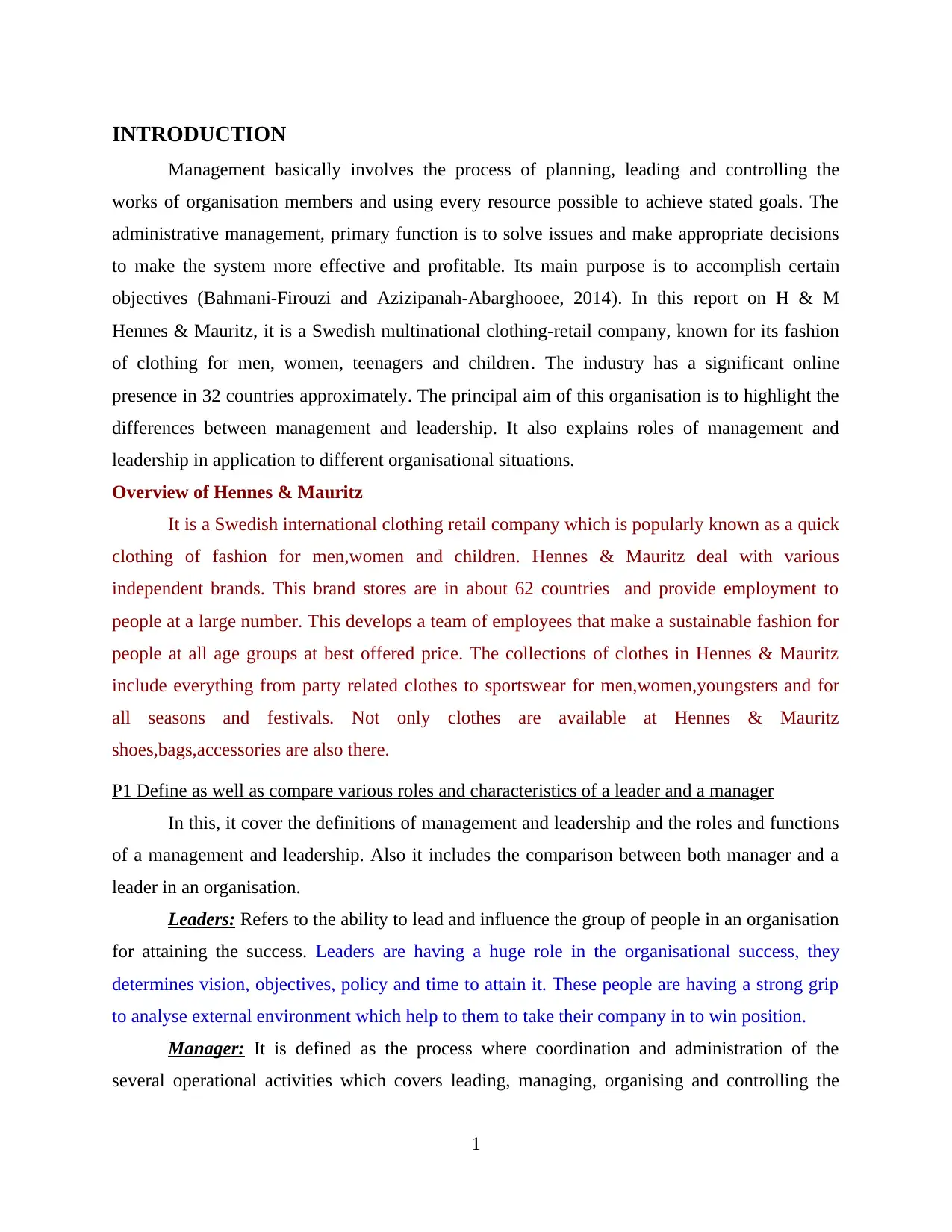
INTRODUCTION
Management basically involves the process of planning, leading and controlling the
works of organisation members and using every resource possible to achieve stated goals. The
administrative management, primary function is to solve issues and make appropriate decisions
to make the system more effective and profitable. Its main purpose is to accomplish certain
objectives (Bahmani-Firouzi and Azizipanah-Abarghooee, 2014). In this report on H & M
Hennes & Mauritz, it is a Swedish multinational clothing-retail company, known for its fashion
of clothing for men, women, teenagers and children. The industry has a significant online
presence in 32 countries approximately. The principal aim of this organisation is to highlight the
differences between management and leadership. It also explains roles of management and
leadership in application to different organisational situations.
Overview of Hennes & Mauritz
It is a Swedish international clothing retail company which is popularly known as a quick
clothing of fashion for men,women and children. Hennes & Mauritz deal with various
independent brands. This brand stores are in about 62 countries and provide employment to
people at a large number. This develops a team of employees that make a sustainable fashion for
people at all age groups at best offered price. The collections of clothes in Hennes & Mauritz
include everything from party related clothes to sportswear for men,women,youngsters and for
all seasons and festivals. Not only clothes are available at Hennes & Mauritz
shoes,bags,accessories are also there.
P1 Define as well as compare various roles and characteristics of a leader and a manager
In this, it cover the definitions of management and leadership and the roles and functions
of a management and leadership. Also it includes the comparison between both manager and a
leader in an organisation.
Leaders: Refers to the ability to lead and influence the group of people in an organisation
for attaining the success. Leaders are having a huge role in the organisational success, they
determines vision, objectives, policy and time to attain it. These people are having a strong grip
to analyse external environment which help to them to take their company in to win position.
Manager: It is defined as the process where coordination and administration of the
several operational activities which covers leading, managing, organising and controlling the
1
Management basically involves the process of planning, leading and controlling the
works of organisation members and using every resource possible to achieve stated goals. The
administrative management, primary function is to solve issues and make appropriate decisions
to make the system more effective and profitable. Its main purpose is to accomplish certain
objectives (Bahmani-Firouzi and Azizipanah-Abarghooee, 2014). In this report on H & M
Hennes & Mauritz, it is a Swedish multinational clothing-retail company, known for its fashion
of clothing for men, women, teenagers and children. The industry has a significant online
presence in 32 countries approximately. The principal aim of this organisation is to highlight the
differences between management and leadership. It also explains roles of management and
leadership in application to different organisational situations.
Overview of Hennes & Mauritz
It is a Swedish international clothing retail company which is popularly known as a quick
clothing of fashion for men,women and children. Hennes & Mauritz deal with various
independent brands. This brand stores are in about 62 countries and provide employment to
people at a large number. This develops a team of employees that make a sustainable fashion for
people at all age groups at best offered price. The collections of clothes in Hennes & Mauritz
include everything from party related clothes to sportswear for men,women,youngsters and for
all seasons and festivals. Not only clothes are available at Hennes & Mauritz
shoes,bags,accessories are also there.
P1 Define as well as compare various roles and characteristics of a leader and a manager
In this, it cover the definitions of management and leadership and the roles and functions
of a management and leadership. Also it includes the comparison between both manager and a
leader in an organisation.
Leaders: Refers to the ability to lead and influence the group of people in an organisation
for attaining the success. Leaders are having a huge role in the organisational success, they
determines vision, objectives, policy and time to attain it. These people are having a strong grip
to analyse external environment which help to them to take their company in to win position.
Manager: It is defined as the process where coordination and administration of the
several operational activities which covers leading, managing, organising and controlling the
1
Paraphrase This Document
Need a fresh take? Get an instant paraphrase of this document with our AI Paraphraser
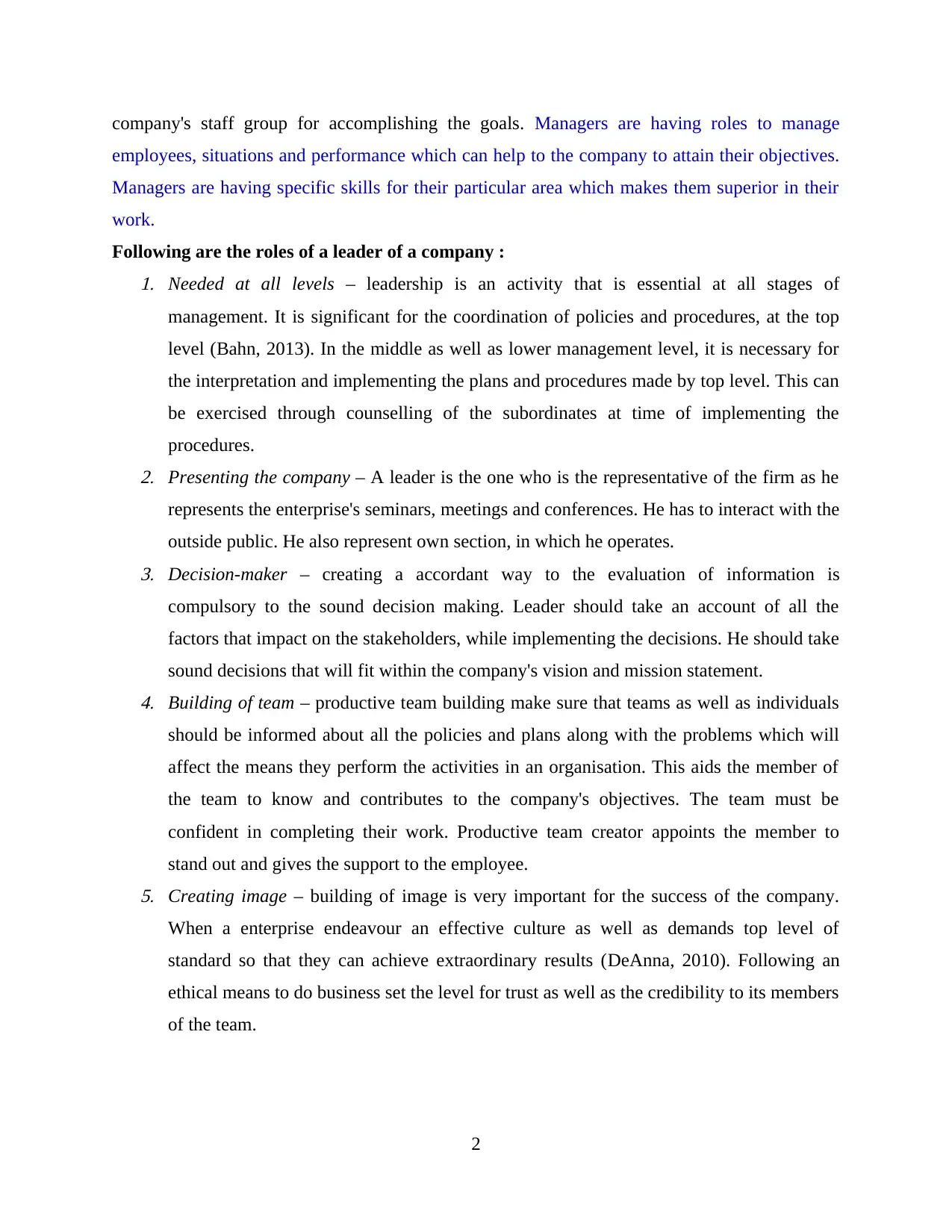
company's staff group for accomplishing the goals. Managers are having roles to manage
employees, situations and performance which can help to the company to attain their objectives.
Managers are having specific skills for their particular area which makes them superior in their
work.
Following are the roles of a leader of a company :1. Needed at all levels – leadership is an activity that is essential at all stages of
management. It is significant for the coordination of policies and procedures, at the top
level (Bahn, 2013). In the middle as well as lower management level, it is necessary for
the interpretation and implementing the plans and procedures made by top level. This can
be exercised through counselling of the subordinates at time of implementing the
procedures.2. Presenting the company – A leader is the one who is the representative of the firm as he
represents the enterprise's seminars, meetings and conferences. He has to interact with the
outside public. He also represent own section, in which he operates.3. Decision-maker – creating a accordant way to the evaluation of information is
compulsory to the sound decision making. Leader should take an account of all the
factors that impact on the stakeholders, while implementing the decisions. He should take
sound decisions that will fit within the company's vision and mission statement.4. Building of team – productive team building make sure that teams as well as individuals
should be informed about all the policies and plans along with the problems which will
affect the means they perform the activities in an organisation. This aids the member of
the team to know and contributes to the company's objectives. The team must be
confident in completing their work. Productive team creator appoints the member to
stand out and gives the support to the employee.5. Creating image – building of image is very important for the success of the company.
When a enterprise endeavour an effective culture as well as demands top level of
standard so that they can achieve extraordinary results (DeAnna, 2010). Following an
ethical means to do business set the level for trust as well as the credibility to its members
of the team.
2
employees, situations and performance which can help to the company to attain their objectives.
Managers are having specific skills for their particular area which makes them superior in their
work.
Following are the roles of a leader of a company :1. Needed at all levels – leadership is an activity that is essential at all stages of
management. It is significant for the coordination of policies and procedures, at the top
level (Bahn, 2013). In the middle as well as lower management level, it is necessary for
the interpretation and implementing the plans and procedures made by top level. This can
be exercised through counselling of the subordinates at time of implementing the
procedures.2. Presenting the company – A leader is the one who is the representative of the firm as he
represents the enterprise's seminars, meetings and conferences. He has to interact with the
outside public. He also represent own section, in which he operates.3. Decision-maker – creating a accordant way to the evaluation of information is
compulsory to the sound decision making. Leader should take an account of all the
factors that impact on the stakeholders, while implementing the decisions. He should take
sound decisions that will fit within the company's vision and mission statement.4. Building of team – productive team building make sure that teams as well as individuals
should be informed about all the policies and plans along with the problems which will
affect the means they perform the activities in an organisation. This aids the member of
the team to know and contributes to the company's objectives. The team must be
confident in completing their work. Productive team creator appoints the member to
stand out and gives the support to the employee.5. Creating image – building of image is very important for the success of the company.
When a enterprise endeavour an effective culture as well as demands top level of
standard so that they can achieve extraordinary results (DeAnna, 2010). Following an
ethical means to do business set the level for trust as well as the credibility to its members
of the team.
2
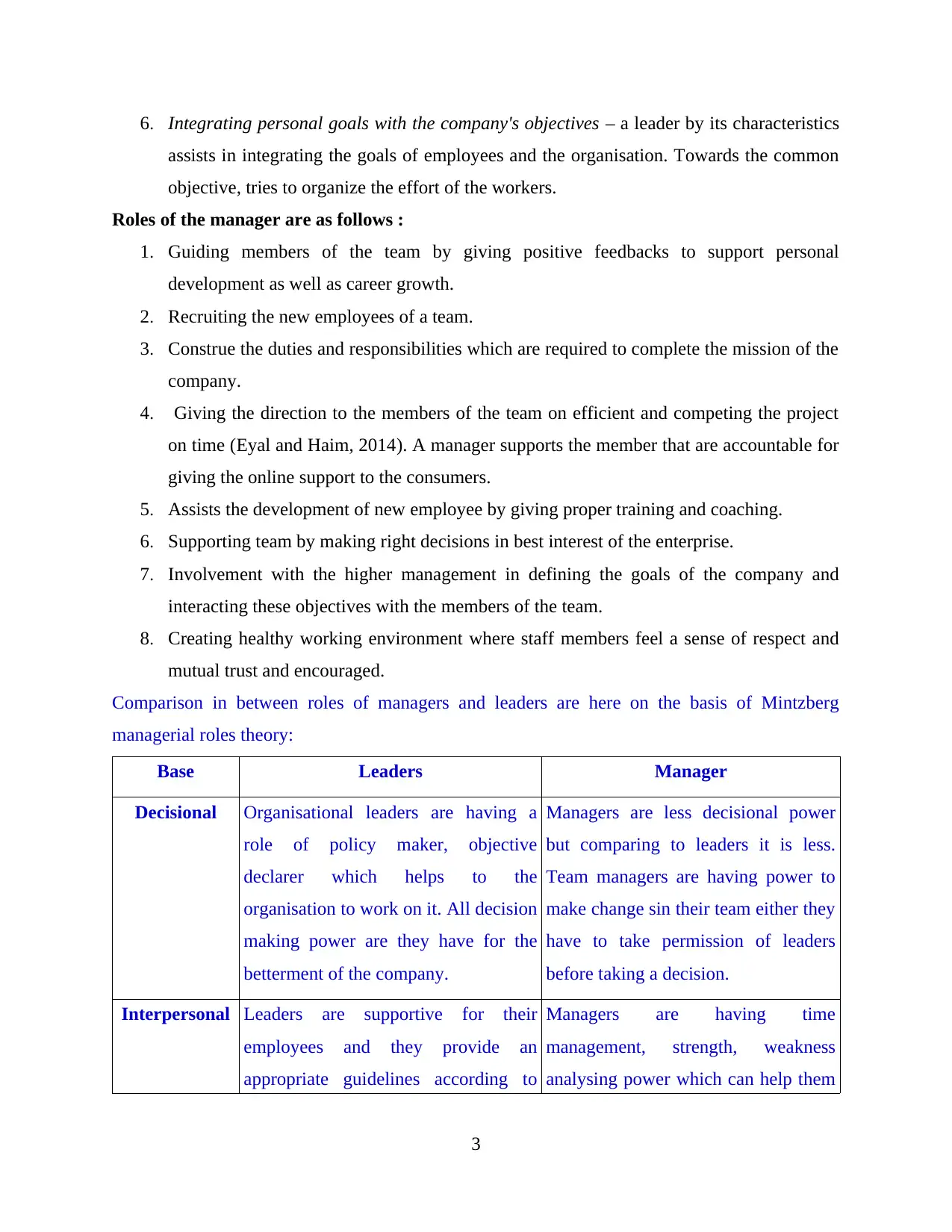
6. Integrating personal goals with the company's objectives – a leader by its characteristics
assists in integrating the goals of employees and the organisation. Towards the common
objective, tries to organize the effort of the workers.
Roles of the manager are as follows :
1. Guiding members of the team by giving positive feedbacks to support personal
development as well as career growth.
2. Recruiting the new employees of a team.
3. Construe the duties and responsibilities which are required to complete the mission of the
company.
4. Giving the direction to the members of the team on efficient and competing the project
on time (Eyal and Haim, 2014). A manager supports the member that are accountable for
giving the online support to the consumers.
5. Assists the development of new employee by giving proper training and coaching.
6. Supporting team by making right decisions in best interest of the enterprise.
7. Involvement with the higher management in defining the goals of the company and
interacting these objectives with the members of the team.
8. Creating healthy working environment where staff members feel a sense of respect and
mutual trust and encouraged.
Comparison in between roles of managers and leaders are here on the basis of Mintzberg
managerial roles theory:
Base Leaders Manager
Decisional Organisational leaders are having a
role of policy maker, objective
declarer which helps to the
organisation to work on it. All decision
making power are they have for the
betterment of the company.
Managers are less decisional power
but comparing to leaders it is less.
Team managers are having power to
make change sin their team either they
have to take permission of leaders
before taking a decision.
Interpersonal Leaders are supportive for their
employees and they provide an
appropriate guidelines according to
Managers are having time
management, strength, weakness
analysing power which can help them
3
assists in integrating the goals of employees and the organisation. Towards the common
objective, tries to organize the effort of the workers.
Roles of the manager are as follows :
1. Guiding members of the team by giving positive feedbacks to support personal
development as well as career growth.
2. Recruiting the new employees of a team.
3. Construe the duties and responsibilities which are required to complete the mission of the
company.
4. Giving the direction to the members of the team on efficient and competing the project
on time (Eyal and Haim, 2014). A manager supports the member that are accountable for
giving the online support to the consumers.
5. Assists the development of new employee by giving proper training and coaching.
6. Supporting team by making right decisions in best interest of the enterprise.
7. Involvement with the higher management in defining the goals of the company and
interacting these objectives with the members of the team.
8. Creating healthy working environment where staff members feel a sense of respect and
mutual trust and encouraged.
Comparison in between roles of managers and leaders are here on the basis of Mintzberg
managerial roles theory:
Base Leaders Manager
Decisional Organisational leaders are having a
role of policy maker, objective
declarer which helps to the
organisation to work on it. All decision
making power are they have for the
betterment of the company.
Managers are less decisional power
but comparing to leaders it is less.
Team managers are having power to
make change sin their team either they
have to take permission of leaders
before taking a decision.
Interpersonal Leaders are supportive for their
employees and they provide an
appropriate guidelines according to
Managers are having time
management, strength, weakness
analysing power which can help them
3
⊘ This is a preview!⊘
Do you want full access?
Subscribe today to unlock all pages.

Trusted by 1+ million students worldwide
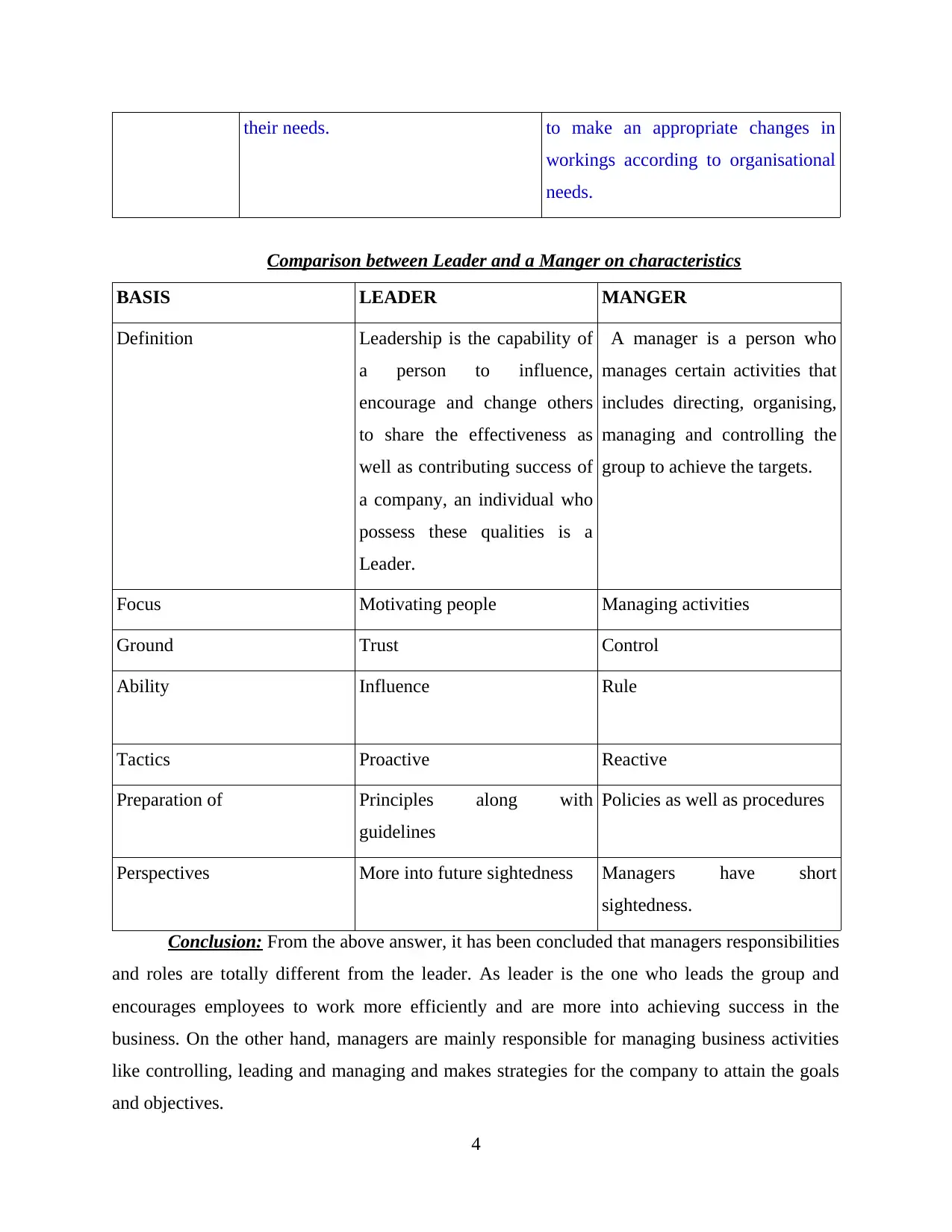
their needs. to make an appropriate changes in
workings according to organisational
needs.
Comparison between Leader and a Manger on characteristics
BASIS LEADER MANGER
Definition Leadership is the capability of
a person to influence,
encourage and change others
to share the effectiveness as
well as contributing success of
a company, an individual who
possess these qualities is a
Leader.
A manager is a person who
manages certain activities that
includes directing, organising,
managing and controlling the
group to achieve the targets.
Focus Motivating people Managing activities
Ground Trust Control
Ability Influence Rule
Tactics Proactive Reactive
Preparation of Principles along with
guidelines
Policies as well as procedures
Perspectives More into future sightedness Managers have short
sightedness.
Conclusion: From the above answer, it has been concluded that managers responsibilities
and roles are totally different from the leader. As leader is the one who leads the group and
encourages employees to work more efficiently and are more into achieving success in the
business. On the other hand, managers are mainly responsible for managing business activities
like controlling, leading and managing and makes strategies for the company to attain the goals
and objectives.
4
workings according to organisational
needs.
Comparison between Leader and a Manger on characteristics
BASIS LEADER MANGER
Definition Leadership is the capability of
a person to influence,
encourage and change others
to share the effectiveness as
well as contributing success of
a company, an individual who
possess these qualities is a
Leader.
A manager is a person who
manages certain activities that
includes directing, organising,
managing and controlling the
group to achieve the targets.
Focus Motivating people Managing activities
Ground Trust Control
Ability Influence Rule
Tactics Proactive Reactive
Preparation of Principles along with
guidelines
Policies as well as procedures
Perspectives More into future sightedness Managers have short
sightedness.
Conclusion: From the above answer, it has been concluded that managers responsibilities
and roles are totally different from the leader. As leader is the one who leads the group and
encourages employees to work more efficiently and are more into achieving success in the
business. On the other hand, managers are mainly responsible for managing business activities
like controlling, leading and managing and makes strategies for the company to attain the goals
and objectives.
4
Paraphrase This Document
Need a fresh take? Get an instant paraphrase of this document with our AI Paraphraser
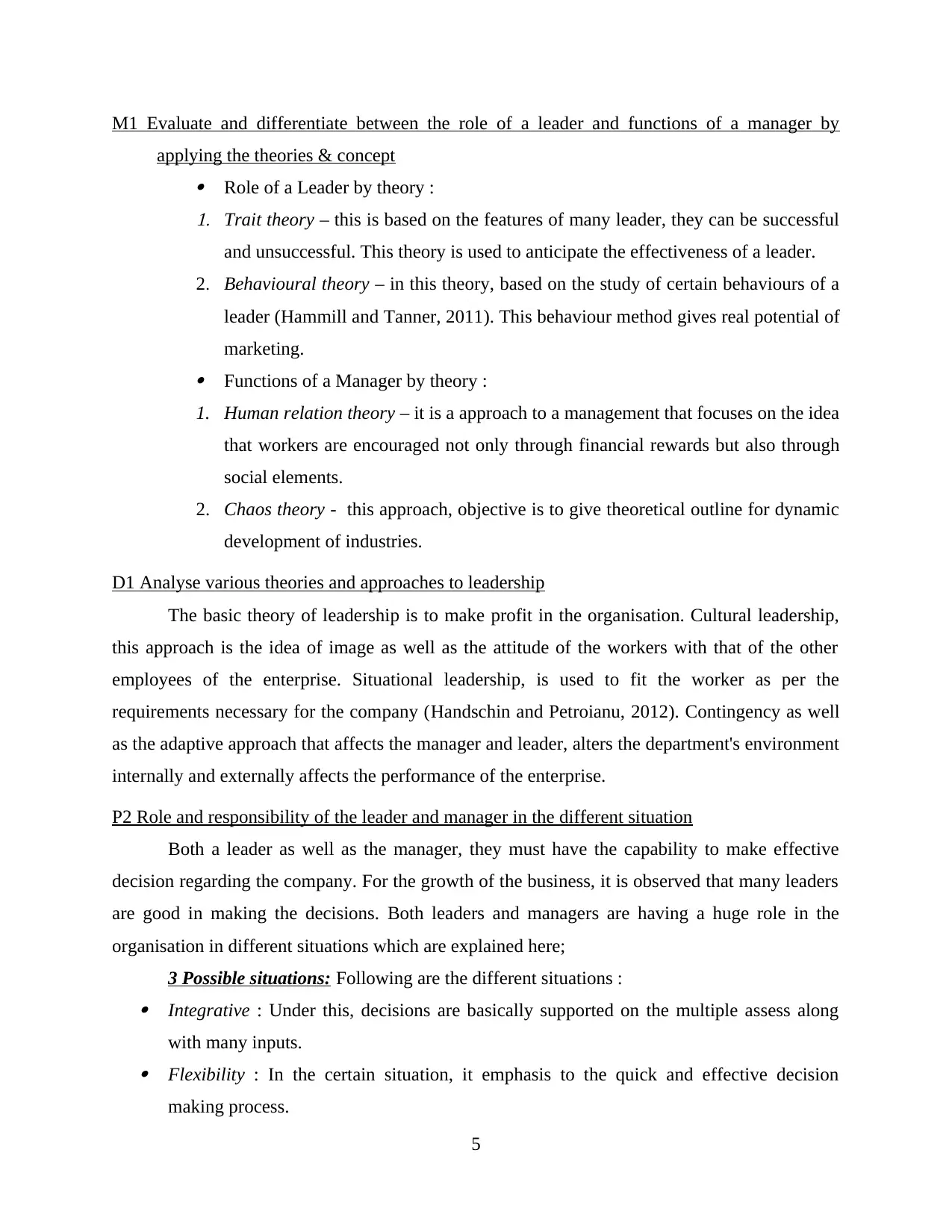
M1 Evaluate and differentiate between the role of a leader and functions of a manager by
applying the theories & concept
Role of a Leader by theory :
1. Trait theory – this is based on the features of many leader, they can be successful
and unsuccessful. This theory is used to anticipate the effectiveness of a leader.
2. Behavioural theory – in this theory, based on the study of certain behaviours of a
leader (Hammill and Tanner, 2011). This behaviour method gives real potential of
marketing.
Functions of a Manager by theory :
1. Human relation theory – it is a approach to a management that focuses on the idea
that workers are encouraged not only through financial rewards but also through
social elements.
2. Chaos theory - this approach, objective is to give theoretical outline for dynamic
development of industries.
D1 Analyse various theories and approaches to leadership
The basic theory of leadership is to make profit in the organisation. Cultural leadership,
this approach is the idea of image as well as the attitude of the workers with that of the other
employees of the enterprise. Situational leadership, is used to fit the worker as per the
requirements necessary for the company (Handschin and Petroianu, 2012). Contingency as well
as the adaptive approach that affects the manager and leader, alters the department's environment
internally and externally affects the performance of the enterprise.
P2 Role and responsibility of the leader and manager in the different situation
Both a leader as well as the manager, they must have the capability to make effective
decision regarding the company. For the growth of the business, it is observed that many leaders
are good in making the decisions. Both leaders and managers are having a huge role in the
organisation in different situations which are explained here;
3 Possible situations: Following are the different situations : Integrative : Under this, decisions are basically supported on the multiple assess along
with many inputs. Flexibility : In the certain situation, it emphasis to the quick and effective decision
making process.
5
applying the theories & concept
Role of a Leader by theory :
1. Trait theory – this is based on the features of many leader, they can be successful
and unsuccessful. This theory is used to anticipate the effectiveness of a leader.
2. Behavioural theory – in this theory, based on the study of certain behaviours of a
leader (Hammill and Tanner, 2011). This behaviour method gives real potential of
marketing.
Functions of a Manager by theory :
1. Human relation theory – it is a approach to a management that focuses on the idea
that workers are encouraged not only through financial rewards but also through
social elements.
2. Chaos theory - this approach, objective is to give theoretical outline for dynamic
development of industries.
D1 Analyse various theories and approaches to leadership
The basic theory of leadership is to make profit in the organisation. Cultural leadership,
this approach is the idea of image as well as the attitude of the workers with that of the other
employees of the enterprise. Situational leadership, is used to fit the worker as per the
requirements necessary for the company (Handschin and Petroianu, 2012). Contingency as well
as the adaptive approach that affects the manager and leader, alters the department's environment
internally and externally affects the performance of the enterprise.
P2 Role and responsibility of the leader and manager in the different situation
Both a leader as well as the manager, they must have the capability to make effective
decision regarding the company. For the growth of the business, it is observed that many leaders
are good in making the decisions. Both leaders and managers are having a huge role in the
organisation in different situations which are explained here;
3 Possible situations: Following are the different situations : Integrative : Under this, decisions are basically supported on the multiple assess along
with many inputs. Flexibility : In the certain situation, it emphasis to the quick and effective decision
making process.
5
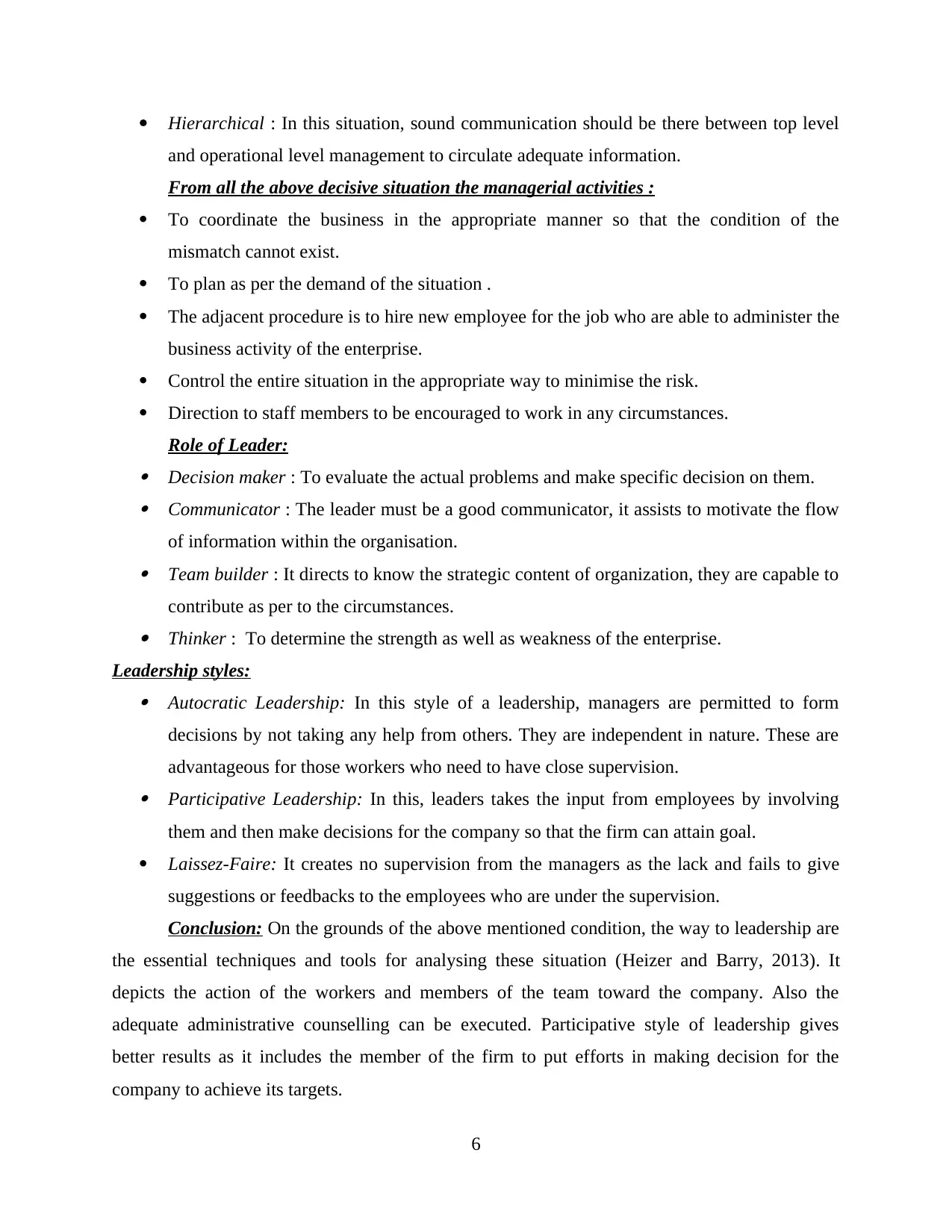
Hierarchical : In this situation, sound communication should be there between top level
and operational level management to circulate adequate information.
From all the above decisive situation the managerial activities :
To coordinate the business in the appropriate manner so that the condition of the
mismatch cannot exist.
To plan as per the demand of the situation .
The adjacent procedure is to hire new employee for the job who are able to administer the
business activity of the enterprise.
Control the entire situation in the appropriate way to minimise the risk.
Direction to staff members to be encouraged to work in any circumstances.
Role of Leader: Decision maker : To evaluate the actual problems and make specific decision on them. Communicator : The leader must be a good communicator, it assists to motivate the flow
of information within the organisation. Team builder : It directs to know the strategic content of organization, they are capable to
contribute as per to the circumstances. Thinker : To determine the strength as well as weakness of the enterprise.
Leadership styles: Autocratic Leadership: In this style of a leadership, managers are permitted to form
decisions by not taking any help from others. They are independent in nature. These are
advantageous for those workers who need to have close supervision. Participative Leadership: In this, leaders takes the input from employees by involving
them and then make decisions for the company so that the firm can attain goal.
Laissez-Faire: It creates no supervision from the managers as the lack and fails to give
suggestions or feedbacks to the employees who are under the supervision.
Conclusion: On the grounds of the above mentioned condition, the way to leadership are
the essential techniques and tools for analysing these situation (Heizer and Barry, 2013). It
depicts the action of the workers and members of the team toward the company. Also the
adequate administrative counselling can be executed. Participative style of leadership gives
better results as it includes the member of the firm to put efforts in making decision for the
company to achieve its targets.
6
and operational level management to circulate adequate information.
From all the above decisive situation the managerial activities :
To coordinate the business in the appropriate manner so that the condition of the
mismatch cannot exist.
To plan as per the demand of the situation .
The adjacent procedure is to hire new employee for the job who are able to administer the
business activity of the enterprise.
Control the entire situation in the appropriate way to minimise the risk.
Direction to staff members to be encouraged to work in any circumstances.
Role of Leader: Decision maker : To evaluate the actual problems and make specific decision on them. Communicator : The leader must be a good communicator, it assists to motivate the flow
of information within the organisation. Team builder : It directs to know the strategic content of organization, they are capable to
contribute as per to the circumstances. Thinker : To determine the strength as well as weakness of the enterprise.
Leadership styles: Autocratic Leadership: In this style of a leadership, managers are permitted to form
decisions by not taking any help from others. They are independent in nature. These are
advantageous for those workers who need to have close supervision. Participative Leadership: In this, leaders takes the input from employees by involving
them and then make decisions for the company so that the firm can attain goal.
Laissez-Faire: It creates no supervision from the managers as the lack and fails to give
suggestions or feedbacks to the employees who are under the supervision.
Conclusion: On the grounds of the above mentioned condition, the way to leadership are
the essential techniques and tools for analysing these situation (Heizer and Barry, 2013). It
depicts the action of the workers and members of the team toward the company. Also the
adequate administrative counselling can be executed. Participative style of leadership gives
better results as it includes the member of the firm to put efforts in making decision for the
company to achieve its targets.
6
⊘ This is a preview!⊘
Do you want full access?
Subscribe today to unlock all pages.

Trusted by 1+ million students worldwide
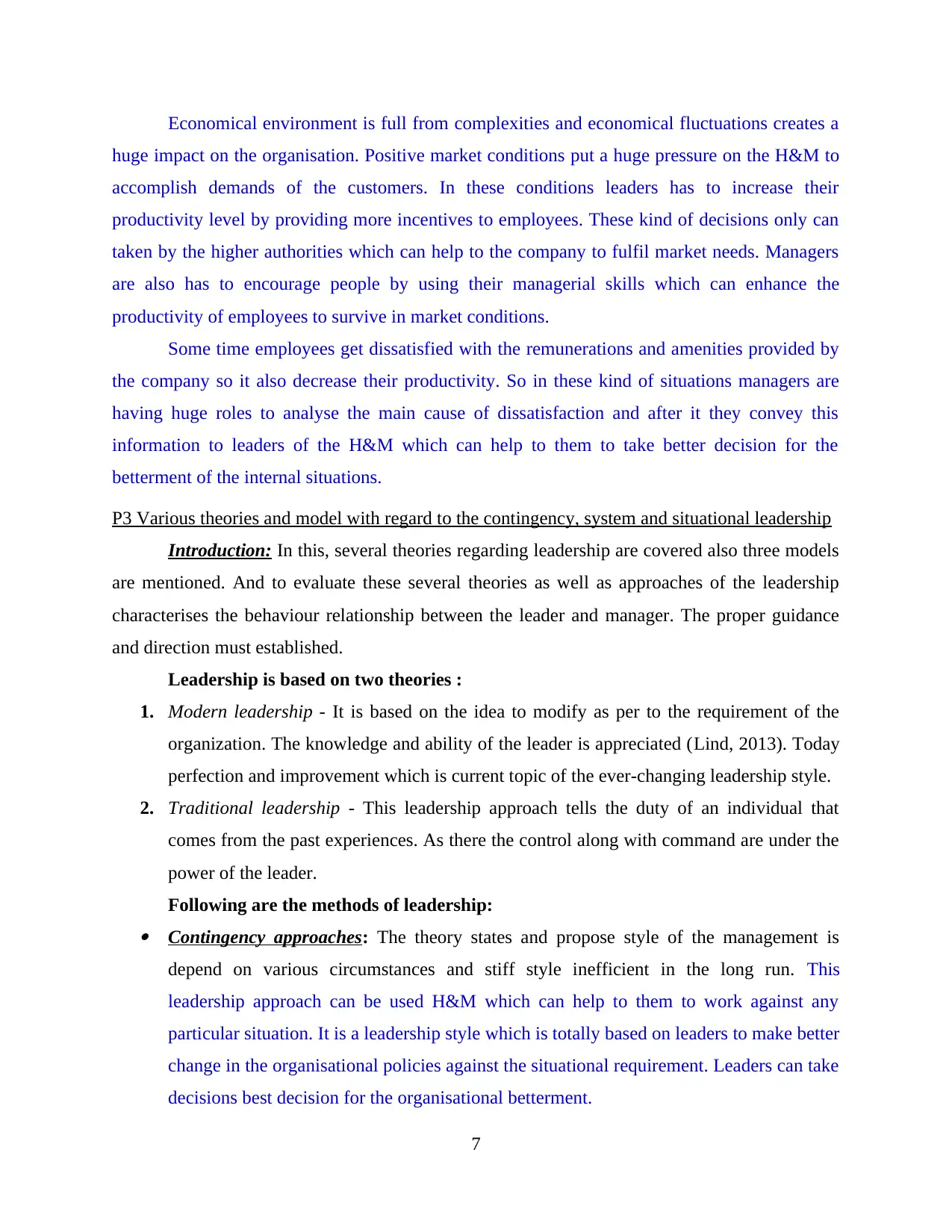
Economical environment is full from complexities and economical fluctuations creates a
huge impact on the organisation. Positive market conditions put a huge pressure on the H&M to
accomplish demands of the customers. In these conditions leaders has to increase their
productivity level by providing more incentives to employees. These kind of decisions only can
taken by the higher authorities which can help to the company to fulfil market needs. Managers
are also has to encourage people by using their managerial skills which can enhance the
productivity of employees to survive in market conditions.
Some time employees get dissatisfied with the remunerations and amenities provided by
the company so it also decrease their productivity. So in these kind of situations managers are
having huge roles to analyse the main cause of dissatisfaction and after it they convey this
information to leaders of the H&M which can help to them to take better decision for the
betterment of the internal situations.
P3 Various theories and model with regard to the contingency, system and situational leadership
Introduction: In this, several theories regarding leadership are covered also three models
are mentioned. And to evaluate these several theories as well as approaches of the leadership
characterises the behaviour relationship between the leader and manager. The proper guidance
and direction must established.
Leadership is based on two theories :
1. Modern leadership - It is based on the idea to modify as per to the requirement of the
organization. The knowledge and ability of the leader is appreciated (Lind, 2013). Today
perfection and improvement which is current topic of the ever-changing leadership style.
2. Traditional leadership - This leadership approach tells the duty of an individual that
comes from the past experiences. As there the control along with command are under the
power of the leader.
Following are the methods of leadership: Contingency approaches: The theory states and propose style of the management is
depend on various circumstances and stiff style inefficient in the long run. This
leadership approach can be used H&M which can help to them to work against any
particular situation. It is a leadership style which is totally based on leaders to make better
change in the organisational policies against the situational requirement. Leaders can take
decisions best decision for the organisational betterment.
7
huge impact on the organisation. Positive market conditions put a huge pressure on the H&M to
accomplish demands of the customers. In these conditions leaders has to increase their
productivity level by providing more incentives to employees. These kind of decisions only can
taken by the higher authorities which can help to the company to fulfil market needs. Managers
are also has to encourage people by using their managerial skills which can enhance the
productivity of employees to survive in market conditions.
Some time employees get dissatisfied with the remunerations and amenities provided by
the company so it also decrease their productivity. So in these kind of situations managers are
having huge roles to analyse the main cause of dissatisfaction and after it they convey this
information to leaders of the H&M which can help to them to take better decision for the
betterment of the internal situations.
P3 Various theories and model with regard to the contingency, system and situational leadership
Introduction: In this, several theories regarding leadership are covered also three models
are mentioned. And to evaluate these several theories as well as approaches of the leadership
characterises the behaviour relationship between the leader and manager. The proper guidance
and direction must established.
Leadership is based on two theories :
1. Modern leadership - It is based on the idea to modify as per to the requirement of the
organization. The knowledge and ability of the leader is appreciated (Lind, 2013). Today
perfection and improvement which is current topic of the ever-changing leadership style.
2. Traditional leadership - This leadership approach tells the duty of an individual that
comes from the past experiences. As there the control along with command are under the
power of the leader.
Following are the methods of leadership: Contingency approaches: The theory states and propose style of the management is
depend on various circumstances and stiff style inefficient in the long run. This
leadership approach can be used H&M which can help to them to work against any
particular situation. It is a leadership style which is totally based on leaders to make better
change in the organisational policies against the situational requirement. Leaders can take
decisions best decision for the organisational betterment.
7
Paraphrase This Document
Need a fresh take? Get an instant paraphrase of this document with our AI Paraphraser
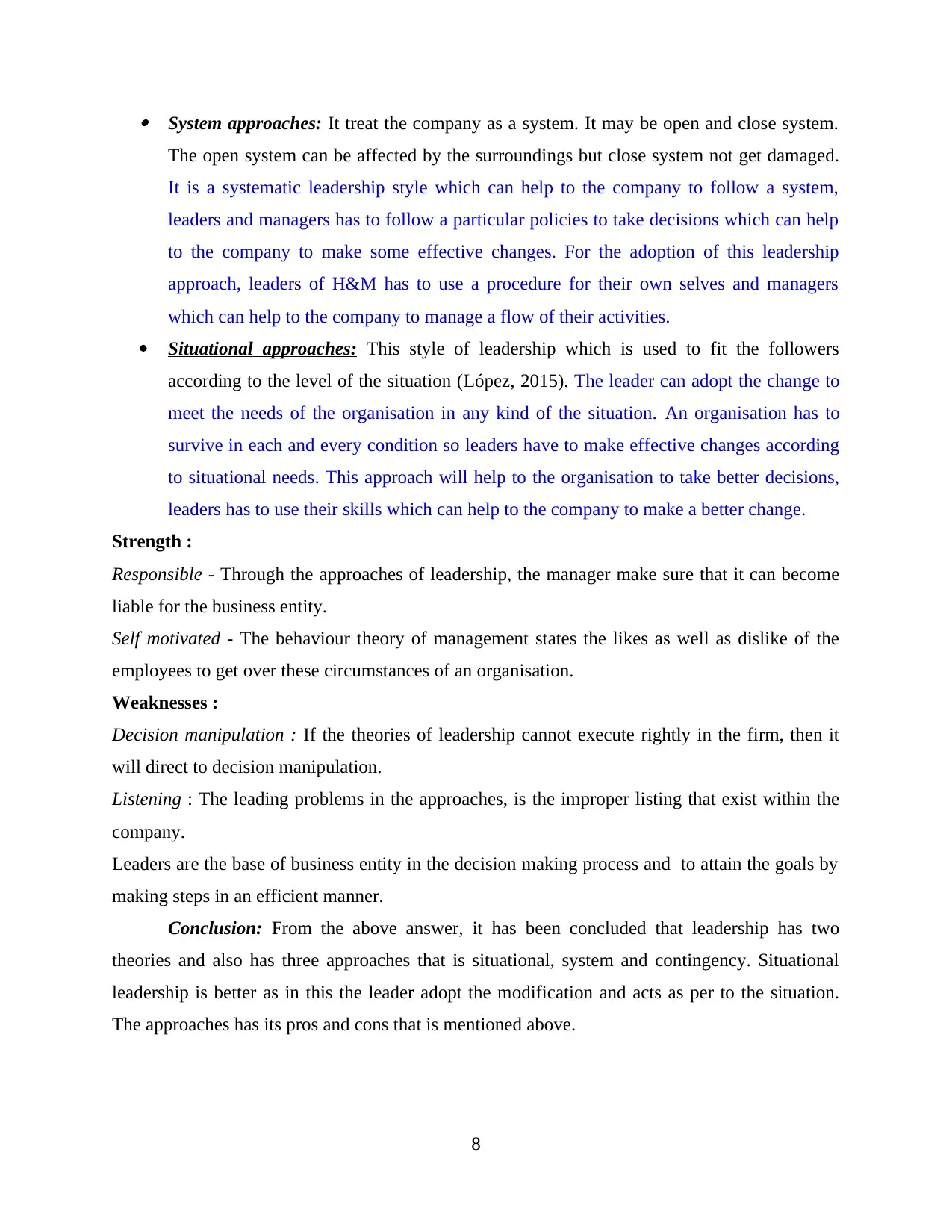
System approaches: It treat the company as a system. It may be open and close system.
The open system can be affected by the surroundings but close system not get damaged.
It is a systematic leadership style which can help to the company to follow a system,
leaders and managers has to follow a particular policies to take decisions which can help
to the company to make some effective changes. For the adoption of this leadership
approach, leaders of H&M has to use a procedure for their own selves and managers
which can help to the company to manage a flow of their activities.
Situational approaches: This style of leadership which is used to fit the followers
according to the level of the situation (López, 2015). The leader can adopt the change to
meet the needs of the organisation in any kind of the situation. An organisation has to
survive in each and every condition so leaders have to make effective changes according
to situational needs. This approach will help to the organisation to take better decisions,
leaders has to use their skills which can help to the company to make a better change.
Strength :
Responsible - Through the approaches of leadership, the manager make sure that it can become
liable for the business entity.
Self motivated - The behaviour theory of management states the likes as well as dislike of the
employees to get over these circumstances of an organisation.
Weaknesses :
Decision manipulation : If the theories of leadership cannot execute rightly in the firm, then it
will direct to decision manipulation.
Listening : The leading problems in the approaches, is the improper listing that exist within the
company.
Leaders are the base of business entity in the decision making process and to attain the goals by
making steps in an efficient manner.
Conclusion: From the above answer, it has been concluded that leadership has two
theories and also has three approaches that is situational, system and contingency. Situational
leadership is better as in this the leader adopt the modification and acts as per to the situation.
The approaches has its pros and cons that is mentioned above.
8
The open system can be affected by the surroundings but close system not get damaged.
It is a systematic leadership style which can help to the company to follow a system,
leaders and managers has to follow a particular policies to take decisions which can help
to the company to make some effective changes. For the adoption of this leadership
approach, leaders of H&M has to use a procedure for their own selves and managers
which can help to the company to manage a flow of their activities.
Situational approaches: This style of leadership which is used to fit the followers
according to the level of the situation (López, 2015). The leader can adopt the change to
meet the needs of the organisation in any kind of the situation. An organisation has to
survive in each and every condition so leaders have to make effective changes according
to situational needs. This approach will help to the organisation to take better decisions,
leaders has to use their skills which can help to the company to make a better change.
Strength :
Responsible - Through the approaches of leadership, the manager make sure that it can become
liable for the business entity.
Self motivated - The behaviour theory of management states the likes as well as dislike of the
employees to get over these circumstances of an organisation.
Weaknesses :
Decision manipulation : If the theories of leadership cannot execute rightly in the firm, then it
will direct to decision manipulation.
Listening : The leading problems in the approaches, is the improper listing that exist within the
company.
Leaders are the base of business entity in the decision making process and to attain the goals by
making steps in an efficient manner.
Conclusion: From the above answer, it has been concluded that leadership has two
theories and also has three approaches that is situational, system and contingency. Situational
leadership is better as in this the leader adopt the modification and acts as per to the situation.
The approaches has its pros and cons that is mentioned above.
8
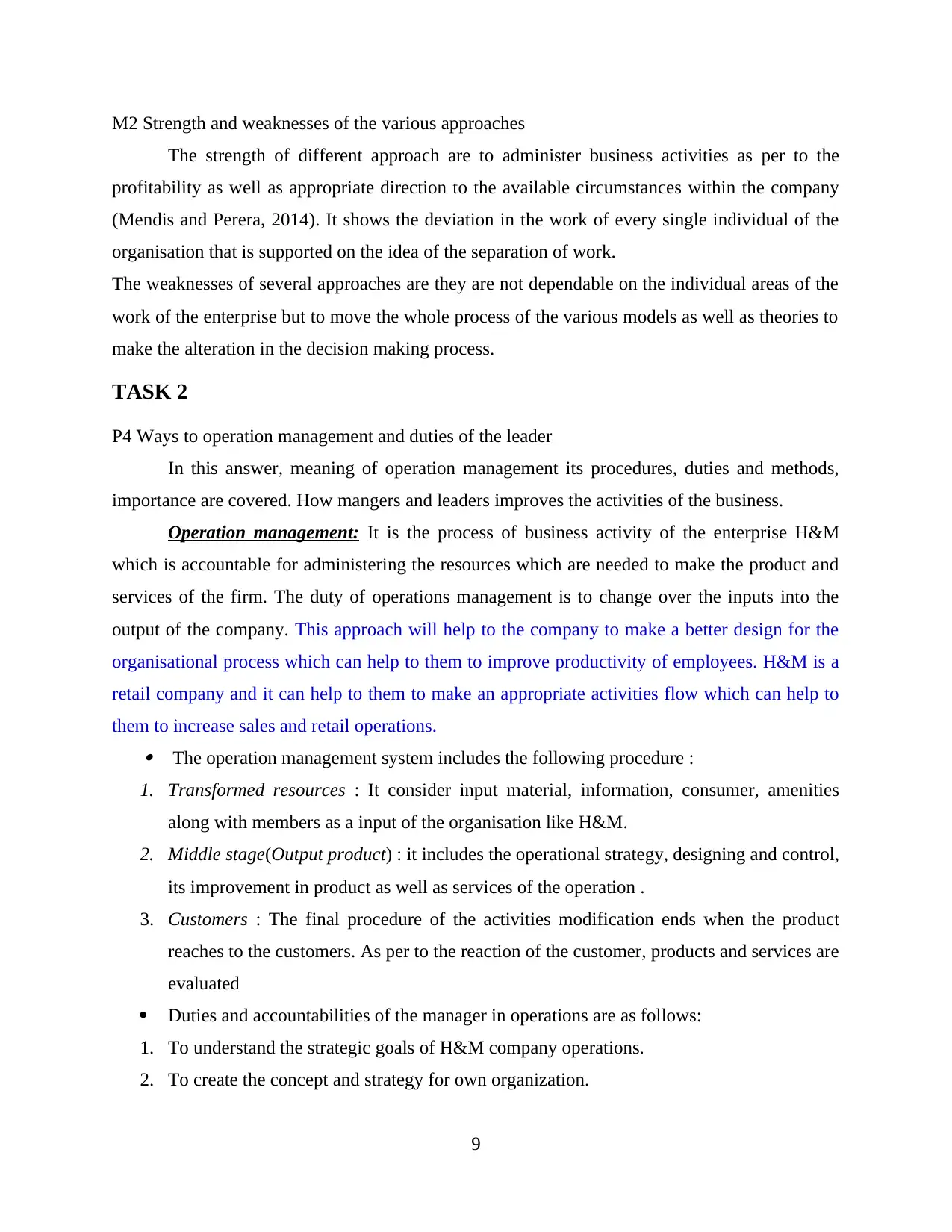
M2 Strength and weaknesses of the various approaches
The strength of different approach are to administer business activities as per to the
profitability as well as appropriate direction to the available circumstances within the company
(Mendis and Perera, 2014). It shows the deviation in the work of every single individual of the
organisation that is supported on the idea of the separation of work.
The weaknesses of several approaches are they are not dependable on the individual areas of the
work of the enterprise but to move the whole process of the various models as well as theories to
make the alteration in the decision making process.
TASK 2
P4 Ways to operation management and duties of the leader
In this answer, meaning of operation management its procedures, duties and methods,
importance are covered. How mangers and leaders improves the activities of the business.
Operation management: It is the process of business activity of the enterprise H&M
which is accountable for administering the resources which are needed to make the product and
services of the firm. The duty of operations management is to change over the inputs into the
output of the company. This approach will help to the company to make a better design for the
organisational process which can help to them to improve productivity of employees. H&M is a
retail company and it can help to them to make an appropriate activities flow which can help to
them to increase sales and retail operations. The operation management system includes the following procedure :
1. Transformed resources : It consider input material, information, consumer, amenities
along with members as a input of the organisation like H&M.
2. Middle stage(Output product) : it includes the operational strategy, designing and control,
its improvement in product as well as services of the operation .
3. Customers : The final procedure of the activities modification ends when the product
reaches to the customers. As per to the reaction of the customer, products and services are
evaluated
Duties and accountabilities of the manager in operations are as follows:
1. To understand the strategic goals of H&M company operations.
2. To create the concept and strategy for own organization.
9
The strength of different approach are to administer business activities as per to the
profitability as well as appropriate direction to the available circumstances within the company
(Mendis and Perera, 2014). It shows the deviation in the work of every single individual of the
organisation that is supported on the idea of the separation of work.
The weaknesses of several approaches are they are not dependable on the individual areas of the
work of the enterprise but to move the whole process of the various models as well as theories to
make the alteration in the decision making process.
TASK 2
P4 Ways to operation management and duties of the leader
In this answer, meaning of operation management its procedures, duties and methods,
importance are covered. How mangers and leaders improves the activities of the business.
Operation management: It is the process of business activity of the enterprise H&M
which is accountable for administering the resources which are needed to make the product and
services of the firm. The duty of operations management is to change over the inputs into the
output of the company. This approach will help to the company to make a better design for the
organisational process which can help to them to improve productivity of employees. H&M is a
retail company and it can help to them to make an appropriate activities flow which can help to
them to increase sales and retail operations. The operation management system includes the following procedure :
1. Transformed resources : It consider input material, information, consumer, amenities
along with members as a input of the organisation like H&M.
2. Middle stage(Output product) : it includes the operational strategy, designing and control,
its improvement in product as well as services of the operation .
3. Customers : The final procedure of the activities modification ends when the product
reaches to the customers. As per to the reaction of the customer, products and services are
evaluated
Duties and accountabilities of the manager in operations are as follows:
1. To understand the strategic goals of H&M company operations.
2. To create the concept and strategy for own organization.
9
⊘ This is a preview!⊘
Do you want full access?
Subscribe today to unlock all pages.

Trusted by 1+ million students worldwide
1 out of 19
Related Documents
Your All-in-One AI-Powered Toolkit for Academic Success.
+13062052269
info@desklib.com
Available 24*7 on WhatsApp / Email
![[object Object]](/_next/static/media/star-bottom.7253800d.svg)
Unlock your academic potential
Copyright © 2020–2025 A2Z Services. All Rights Reserved. Developed and managed by ZUCOL.





